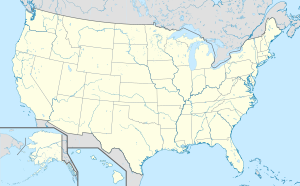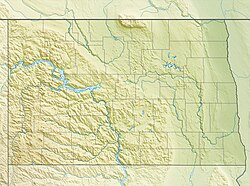Hi-Line Railroad Bridge
Coordinates: 46 ° 56 ′ 20 ″ N , 97 ° 59 ′ 41 ″ W.
| Hi-Line Railroad Bridge | ||
|---|---|---|
| use | Railway bridge | |
| Crossing of |
Sheyenne River Carrington Subdivision ( Canadian Pacific Railway ) |
|
| place | Valley City , North Dakota | |
| Entertained by | BNSF Railway | |
| construction | Trestle Bridge | |
| overall length | 1184 m | |
| Longest span | 31 m | |
| opening | 1908 | |
| location | ||
|
|
||
The Hi-Line Railroad Bridge , also known as the High Bridge or High Line Bridge , is a single-track railroad bridge over the Sheyenne River in northern Valley City , North Dakota . The Trestle Bridge is part of a bypass route built until 1908 for a bridge from the 1870s located over 40 meters deeper in the river valley. This made it possible to significantly reduce the gradients for through traffic. The old and new bridges were part of the Northern Pacific Railway's first northern transcontinental route from Duluth on Lake Superior to Seattle . It is now operated by the BNSF Railway , in which the Northern Pacific was merged through several mergers until 1995. The BNSF uses the bridge for rail freight transport , including transporting coal from the Powder River Basin in Wyoming and Montana .
history

After the completion of the first transcontinental railroad from Sacramento to Omaha in 1869 by the Central Pacific Railroad (CP) and Union Pacific Railroad (UP), which began in Northern Pacific Railway (NP) in 1871 with the construction of a northern transcontinental connection of Duluth on Lake Superior by the states of Minnesota , North Dakota , Idaho , Montana and Washington to Puget Sound on the Pacific coast . In North Dakota, with the Sheyenne , James and Missouri, several larger rivers had to be crossed, where the first settlements arose along the route. From this later cities developed like today's Valley City at the crossing of the Sheyenne, which was built by the construction crews by mid-September 1872. Further west these were Jamestown on James and Bismark on Missouri, which was almost reached before the economic crisis of 1873 . After a break of several years, the Bismark Bridge was finally completed by 1882 and the transcontinental connection in the following year.
For the location of the bridge over the Sheyenne, a point several kilometers wide in the river valley was chosen, where the strongly meandering river temporarily changes its north-south course to the west. This gave enough space for the descent and ascent of the route, which here reached gradients of up to 10 ‰. The route in Valley City roughly followed today's Interstate 94 Business Loop and the river crossing was not far from the Rainbow Arch Bridge . In order to avoid the use of additional push locomotives for through traffic, the Northern Pacific decided at the beginning of the 20th century for a bypass route in the north. The river valley was only a little over a kilometer wide and should be completely spanned with a trestle bridge . This increased the course of the track by 42.9 meters and reduced the gradient to only 0.1 ‰ towards the west (High Line) . Construction work began in June 1906 and lasted until spring 1908; the first train crossed the steel bridge on May 12, 1908.
Although designed for a later double-track expansion, the bridge remained single-track in its more than 100 years of existence, the original Low Line through Valley City existed until 1999. With the expansion of the road network in the USA and the emergence of motorized individual transport, the railroad transported less and less Goods and people, which from the 1960s onwards made the large railroad networks in North America increasingly unprofitable and subsequently led to several bankruptcies and mergers of the railway companies. The NP merged with the Chicago, Burlington and Quincy Railroad , the Spokane, Portland and Seattle Railway and the Great Northern Railway to form the Burlington Northern Railroad (BN) in 1970 . The next major phase of consolidation came in the 1990s, from which a large part of today's Class 1 companies emerged . From the merger of the BN with the Atchison, Topeka and Santa Fe Railway , the BNSF Railway was created , which today operates the Hi-Line Railroad Bridge for rail freight transport on its Jamestown subdivision , including coal transport from the Powder River Basin in Wyoming and Montana .
In 2004, the American Society of Civil Engineers (ASCE) included the bridge as an early example of the steel scaffold pier viaducts still in use in North America in the list of historical milestones in civil engineering .
description
The Trestle Bridge originally only consisted of the 30 steel lattice masts still available today, each with 13.7 m long solid wall girders on the masts, and 31 solid wall girders with lengths between 18.3 m and 30.8 m between them; the total length between the abutments was 1139 m. On the west side above the Sheyenne are two of the three longest spans of 30.8 m, with a mast in the river bed. Another 30.8 m girder is on the east side above the Carrington subdivision of the Canadian Pacific Railway . At a later time, the bridge at the east end was supplemented by two more bridge piers and two solid wall girders and the abutment was relocated accordingly. The total length today is 1184 m. Since the bridge was intended for a double-track expansion with two parallel girders, the existing steel girders are not located on the center line of the bridge, but are located on the north side of the steel lattice masts. The ASCE specifies the height of the bridge as 47 m.
More trestle bridges
| |||
Trestle bridges (scaffolding pillar viaducts) were an effective means of railway construction in the development of the west of the USA , which was largely driven by the expanding railroad companies in the second half of the 19th century. The constructions, which initially consisted exclusively of wood, could be erected in a very short time, the building material was readily available and the building elements could be prefabricated inexpensively. Since the achievable load-bearing capacity was rather low and maintenance and the risk of fire were very high, Trestle bridges were later only made of steel and the wooden structures were mostly replaced. Well-known examples were the Portageville Viaduct from 1852, the Dale Creek Bridge from 1868 or the Marent Gulch Trestle from 1883.
In addition to the Hi-Line Railroad Bridge , two other large trestle bridges were built in North Dakota at that time by the Great Northern Railway , which are still preserved and are now also operated by the BNSF. The Great Northern also built a connection to Seattle parallel to the stretch of the Northern Pacific, which reached the Pacific coast in 1893. It ran in the north of North Dakota from Grand Forks over today's Minot , where in 1887 the 550 m long and 35 m high Gassman Coulee Trestle was built. A tornado destroyed large parts of the wooden structure in 1897, which was replaced by a steel structure the following year. When building another route from Fargo to Minot in the early 1910s, the Great Northern also had to cross the Sheyenne about 50 km upstream from Valley City. These came to 1912 with the Sheyenne River Bridge , a 834 m long steel trestle bridge over the river valley, which here since 1950 part of the reservoir of the dam Bald Hill is (Lake Ashtabula) .
See also
Web links
- Otto Davidson: Construction of High Line Bridge, Valley City, ND State Historical Society of North Dakota (Photos)
- Troy Larson: Northern Pacific High Line Bridge No. 64. Ghosts of North Dakota
Individual evidence
- ^ Valley City Centennial Book Committee: Valley City: City of Five Names. Valley City Times-Record, 1983, pp. 5-8 ( digitized ).
- ↑ Charlotte Brett: Rainbow Arch Bridge (Main Street Bridge). HAER No. ND-14, Washington, DC 2004, p. 9.
- ↑ High Line Bridge. North Dakota Department of Commerce, Tourism Division; accessed on September 17, 2019.
- ^ A b The High Bridge and Water Treating Plant Of the Northern Pacific Railway at Valley City. In: Proceedings - North Dakota Society of Engineers. Vol. 4, 1919, p. 104 f.
- ^ Francis G. Ziegler: North Dakota State Rail Plan. North Dakota Department of Transportation, 2007, p. 67.
- ^ Francis G. Ziegler: North Dakota State Rail Plan. North Dakota Department of Transportation, 2007, p. 79.
- ↑ a b Northern Pacific High Line Bridge No. 64. American Society of Civil Engineers; accessed on September 17, 2019.
- ^ Francis G. Ziegler: North Dakota State Rail Plan. North Dakota Department of Transportation, 2007, p. 92.
- ^ Anthony J. Bianculli: Trains and Technology: The American Railroad in the Nineteenth Century. Volume 4, Univ. of Delaware Press, ISBN 978-0-87413-803-0 , pp. 59-68.
- ^ BNSF - Gassman Coulee Trestle. BridgeHunter.com, accessed September 27, 2019.
- ^ BNSF - Sheyenne River Bridge. BridgeHunter.com, accessed September 27, 2019.






